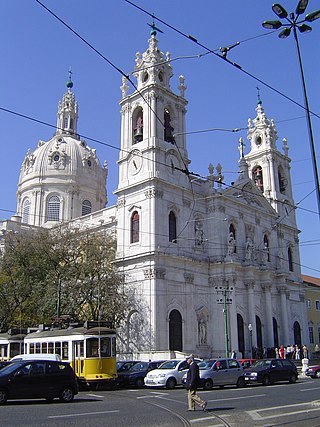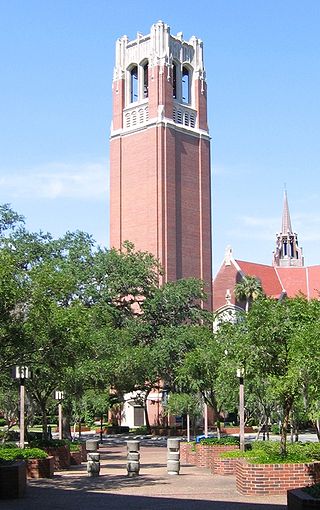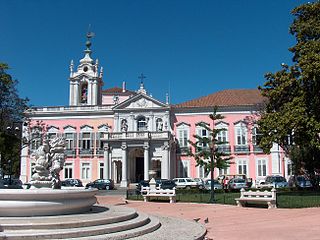
A carillon ( KARR-ə-lon, kə-RIL-yən) is a pitched percussion instrument that is played with a keyboard and consists of at least 23 bells. The bells are cast in bronze, hung in fixed suspension, and tuned in chromatic order so that they can be sounded harmoniously together. They are struck with clappers connected to a keyboard of wooden batons played with the hands and pedals played with the feet. Often housed in bell towers, carillons are usually owned by churches, universities, or municipalities. They can include an automatic system through which the time is announced and simple tunes are played throughout the day.

Campanology is the scientific and musical study of bells. It encompasses the technology of bells – how they are founded, tuned and rung – as well as the history, methods, and traditions of bellringing as an art.

Baroque architecture is a highly decorative and theatrical style which appeared in Italy in the early 17th century and gradually spread across Europe. It was originally introduced by the Catholic Church, particularly by the Jesuits, as a means to combat the Reformation and the Protestant church with a new architecture that inspired surprise and awe. It reached its peak in the High Baroque (1625–1675), when it was used in churches and palaces in Italy, Spain, Portugal, France, Bavaria and Austria. In the Late Baroque period (1675–1750), it reached as far as Russia, the Ottoman Empire and the Spanish and Portuguese colonies in Latin America. In about 1730, an even more elaborately decorative variant called Rococo appeared and flourished in Central Europe.

Mafra is a city and a municipality in the district of Lisbon, on the west coast of Portugal, and part of the urban agglomeration of the Greater Lisbon subregion. The population in 2011 was 76,685, in an area of 291.66 km2.

The National Carillon is a large carillon situated on Queen Elizabeth II Island in Lake Burley Griffin, central Canberra, in the Australian Capital Territory, Australia. The carillon is managed and maintained by the National Capital Authority on behalf of the Commonwealth of Australia. It has 57 bells, ranging nearly 5 octaves from the 6,108 kg (13,466 lb) bass bell in F# to the 8 kg (18 lb) treble bell in D.

The Tapada Nacional de Mafra was created in Mafra, Portugal, during the reign of king João V, following the building of the Mafra National Palace, as a park for royal and court recreation.

The Palace of Mafra, also known as the Palace-Convent of Mafra and the Royal Building of Mafra, is a monumental Baroque and Neoclassical palace-monastery located in Mafra, Portugal, some 28 kilometres from Lisbon. Construction began in 1717 under King John V of Portugal and was completely concluded in 1755.

The Estrela Basilica or the Royal Basilica and Convent of the Most Sacred Heart of Jesus, is a minor basilica and ancient carmelite convent in Lisbon, Portugal.

The Century Tower is a 157-foot-tall (48 m) bell tower containing a carillon in the center of the University of Florida campus in Gainesville, Florida, United States.

Baroque architecture in Portugal lasted about two centuries. The reigns of John V and Joseph I had increased imports of gold and diamonds, in a period called Royal Absolutism or Absolute monarchy, which allowed the Portuguese Baroque to flourish.

The Necessidades Palace is a historic building in the Largo do Rilvas, a public square in Lisbon, Portugal. It serves as headquarters of the Portuguese Foreign Ministry. The Palace has been classified as a Property of Public Interest since 1983.

The Castle of the Moors is a hilltop medieval castle located in the central Portuguese civil parish of Santa Maria e São Miguel, in the municipality of Sintra, about 25 km (16 mi) northwest of Lisbon. Built by the Moors in the 8th and 9th centuries, it was an important strategic point during the Reconquista, and was taken by Christian forces after the fall of Lisbon in 1147. It is classified as a National Monument, part of the Sintra Cultural Landscape, a UNESCO World Heritage Site.

The Royal and Venerable Confraternity of the Most Blessed Sacrament of Mafra, alternatively, the Royal and Venerable Brotherhood of the Most Blessed Sacrament of Mafra, is a public association of faithful of the Catholic Church, canonically established in the Basilica of Our Lady and Saint Anthony of Mafra, Portugal.

The Basilica of Our Lady and Saint Anthony of Mafra is a Roman Catholic shrine and basilica located within the Palace of Mafra, Portugal. It is designated as a Basilica by the privilege of immemorial status.

The Sanctuary of St. Paschal Baylon, popularly known as El Sant, is located in Villarreal, in the province of Castellón (Spain). The complex consists of the "International Eucharistic Votive Temple", proclaimed a minor basilica by Pope John Paul II, the Royal Chapel with the tomb of Saint Paschal Baylon, the museum of the Pouet del Sant and the cloistered convent of the Poor Clare Mothers.

















